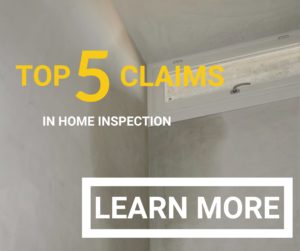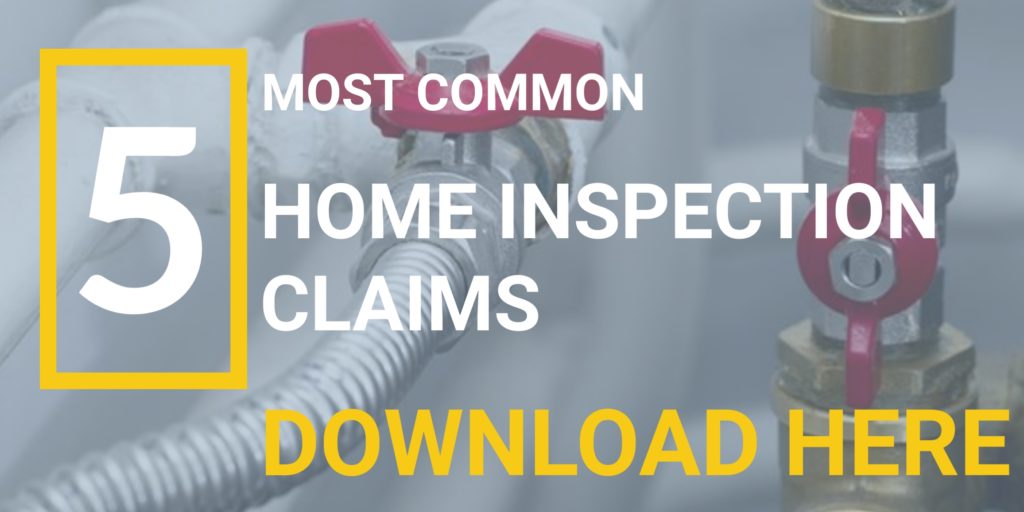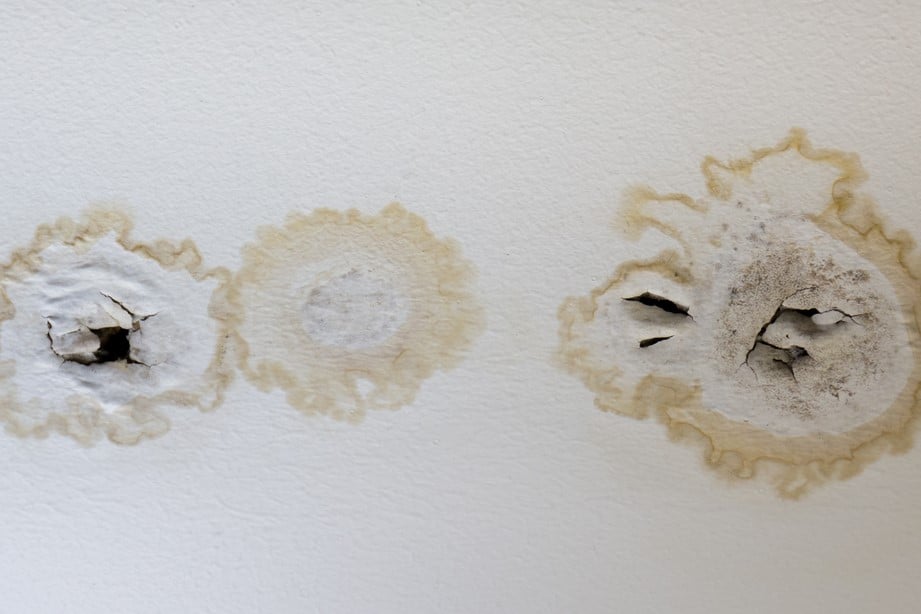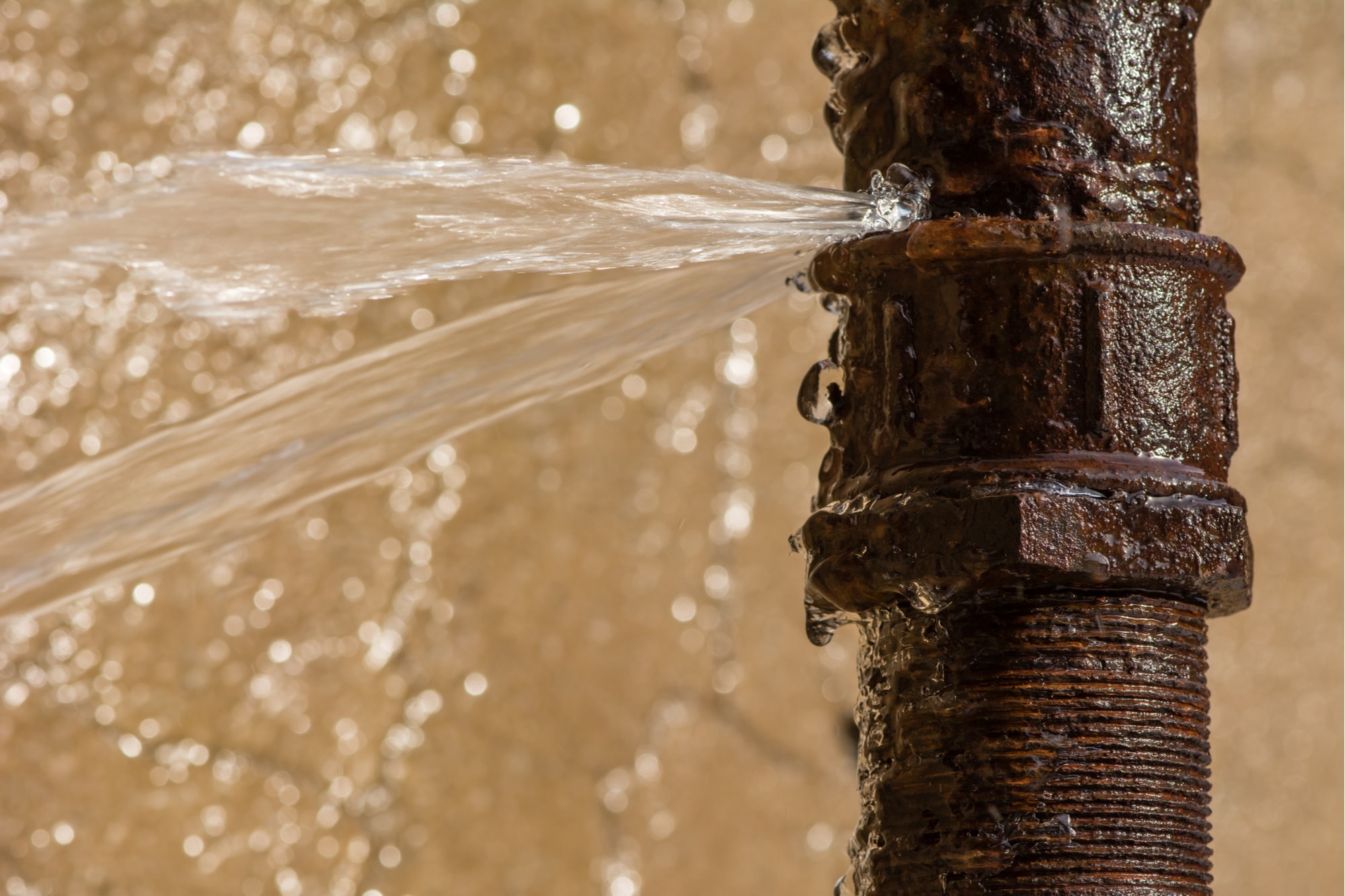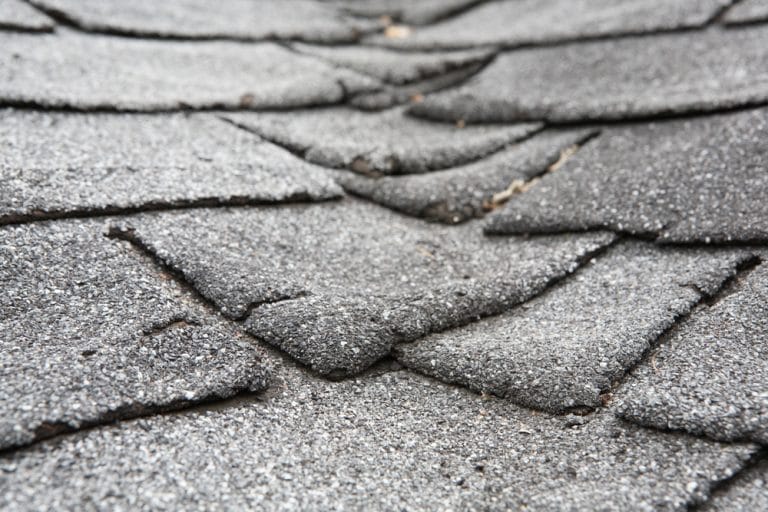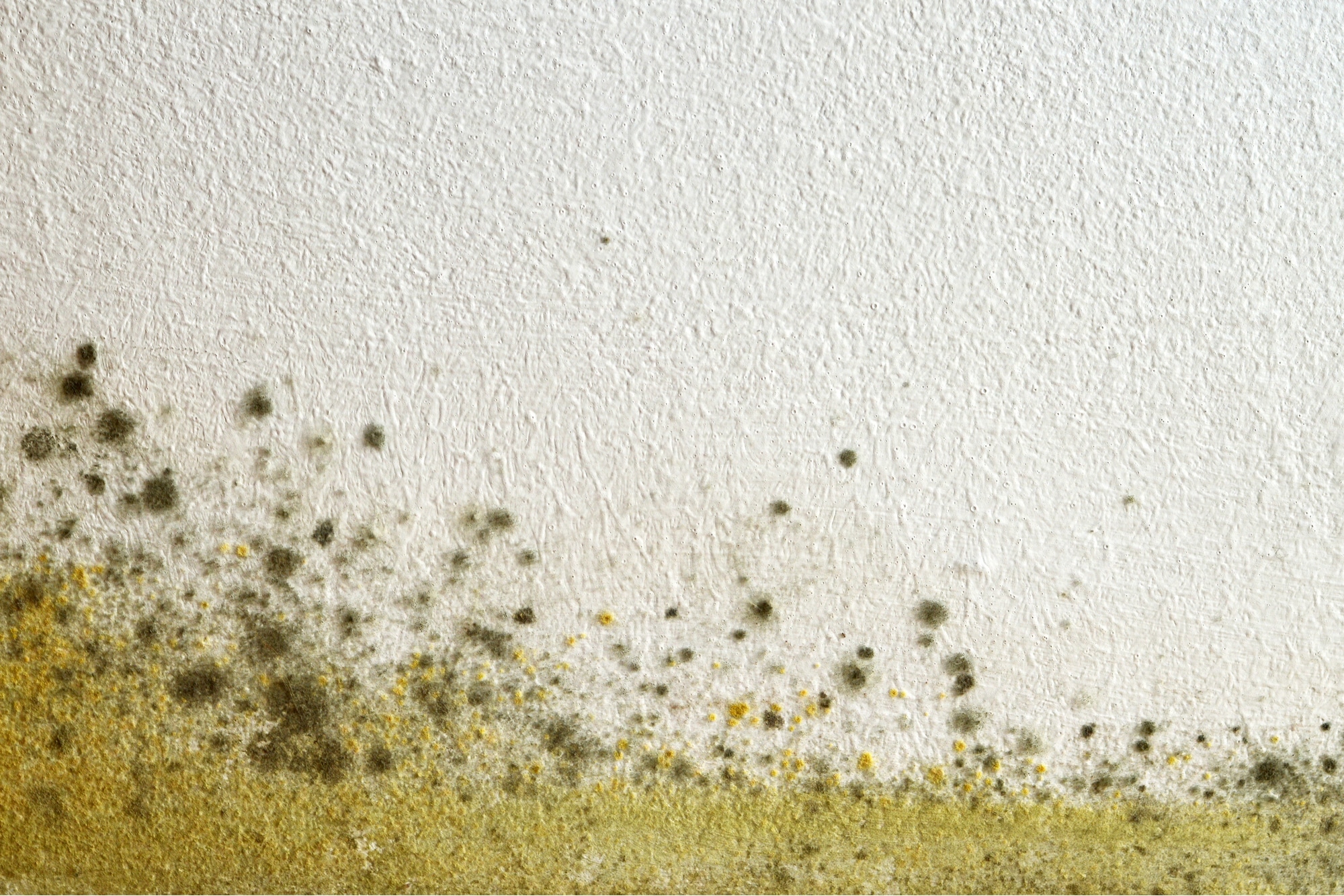Top 5 Claims Against Home Inspectors
Last Updated November 21, 2024
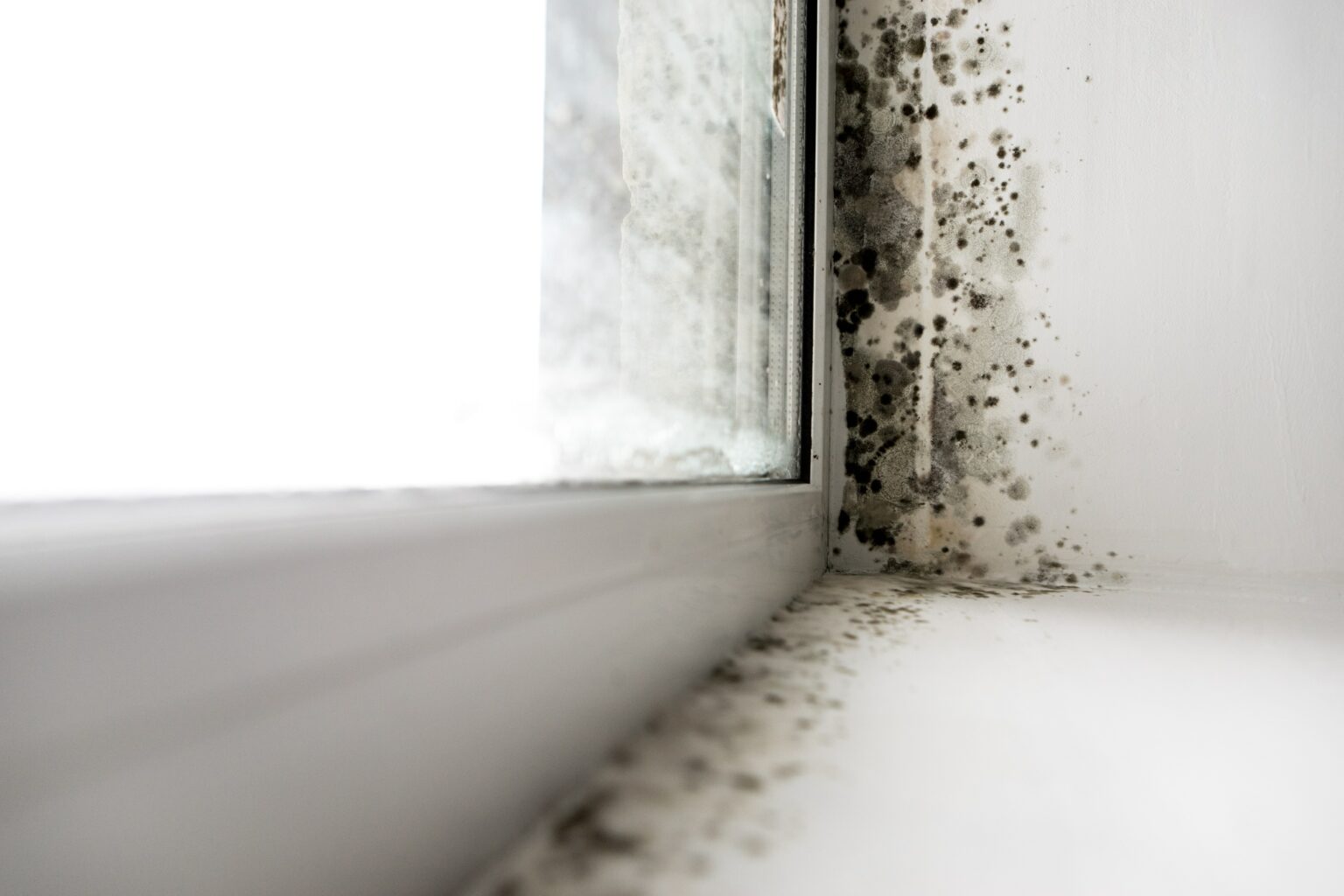
In 2016, we published an article featuring the top five claims home inspectors face each year and what you can do to mitigate your risk. Those allegations—water damage, roof issues, foundation defects, mold, and plumbing problems—continue to be common. We revisit each claim type by looking at recent claims from our archives and the lessons we can learn from each of them.
1. Water Damage
The Claim
The Allegation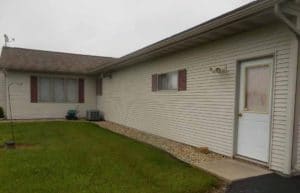
A year and a few months after the inspection, a home inspector received an attorney letter demanding thousands in repair expenses. The claimants, a married couple, alleged that the home inspector failed to report significant defects to the property’s front stoop. Since the inspection, water had entered the basement between the front porch and the vinyl siding, causing damage to the home. The claimants argued that they could have avoided this damage had the inspection report provided more information.
By the time the inspector received the attorney letter, the claimants had already removed and replaced the stoop. The construction company that repaired the stoop had written a five-page letter on the claimants’ behalf. In that letter, the company argued that the inspector had failed to perform an adequate inspection. The inspector should have noticed the “musty smell” in the basement, the company argued. He photographed but did not call out the water stains on the exterior siding, the company wrote. Lastly, the company stated, the inspector should have made recommendations to prevent future water intrusion.
But the construction company’s letter was inaccurate. According to the American Society of Home Inspectors’ (ASHI) Standard of Practice (SOP), the home inspector was “NOT required to determine…the strength, adequacy, effectiveness, and efficiency of systems and components.” The home inspector was only required to report on and describe the type of materials used, which he did.
Further, the home inspector identified that the owners had made repairs to the stoop. He then recommended that the claimants monitor those repairs to ensure they were sufficient. Thus, the water staining the inspector photographed and reported was redundant; the owners had already disclosed the damage, so the staining provided no basis for further action.
The Resolution
Our claims department sent the claimants a denial of liability letter, a formal letter that rejects the claimants’ allegations and highlights some of the key reasons why the inspector is innocent. In the letter, the claims professionals argued that the inspector had followed the SOP and performed a proper inspection. In addition to demonstrating how the inspector met the SOP in his report, our claims team explained how the construction company’s letter manipulated what visual property exams actually require.
“[The contractor] had the benefit of knowing what the issue was, focused on that issue, and looked for differences between what the [home inspector] reported and what he would have liked to have seen in the report,” the claims team explained. “A failure to detect defects which are not visible and within the SOP is not negligence, as a matter of law.”
Upon receiving the denial of liability letter, the claimants amended their demand to by a thousand dollars. Over the next six months, the claims team continued to defend that the home inspector had done nothing wrong. While the demand amount slowly trickled down, the claimants’ assertion that the inspector had done nothing wrong did not wane. After much deliberation, our claims team settled for half of the original demand and a release of all claims.
Key Takeaways
In an effort to make more money, it’s not uncommon for sellers to attempt to take care of existing defects prior to posting their properties for sale. And if those sellers are on a budget—which they often are—poor do-it-yourself repairs may occur.
While, as a home inspector, it is not your job to diagnose repairs’ proficiency, it is important for you to draw attention to repairs. Your clients need to know that just because the seller repaired a defect does not guarantee they repaired it well. Including clauses that identify repairs and your clients’ duty to monitor those repairs, as the home inspector in this example did, is a good way to deter and combat claims.
In addition, it’s common for third parties, like the construction contractor in this example, to cast doubt or blame on home inspectors. Therefore, it’s important for home inspectors to be particularly cautious and vigilant.
One way to prevent future contractors’ condemnation is to work with them from the beginning. Since receiving this claim, our inspector home inspector has a contractor verify all repairs at the time of the inspection. While such a practice goes beyond the SOP and does require extra work, our inspector feels more at ease being able to report on repair work more thoroughly.
Lastly, in this particular example, whether or not the water damage existed on inspection day is still largely up for debate. Be sure to emphasize that you can only diagnose the property’s systems and components on the day of the inspection and cannot predict what may occur in the future. In so doing, you protect your business from defects that reveal themselves after weather, use, or time alter conditions.
To learn more about water damage claims, read our stand-alone article on the subject here.
 2. Roof Issues
2. Roof Issues
The Claim
The Allegation
Nine months after his inspection of the home, another home inspector received an email from his inspection clients. Recently, his clients had noticed a leak in the roof and called a professional roofer to fix the issue.
When the roofer arrived to the property and saw the roof, he refused to perform the repair work. According to the inspection clients, the roofer “said that there was no way anyone with any training in roofing put that roof on, and that there is no way that it should have passed the inspection.”
Wanting to prioritize customer service, our home inspector contacted a roofer in his network to perform the repairs. The inspector assured his clients that, once the roofer completed the repairs, the roof issues should stop.
Three months later, additional leaks appeared in separate areas of the home. The client emailed the home inspector again, claiming that, since the contractor completed the repairs, the roof was worse. The client threatened to take legal action and file a complaint with the state licensing board if the home inspector did not pay for the latest damage and repairs. That’s when our home inspector reported the claim to us.
The Resolution
Upon reviewing the inspection assets, including the pre-inspection agreement and report, our claims team found that the home inspector had observed that the roof had raised shingles and improperly installed gutters that could lead to water damage. Further, the inspector had advised the client to have a professional roofing contractor evaluate the entire roof. Had the client followed through on the home inspector’s recommendations, they would not have had to confront roofing issues nine months later. Thus, our claims team sent a denial of liability letter to the claimant on behalf of the home inspector.
When the client received the letter denying our home inspector’s liability, he continued to persist, arguing that the inspector should have called out the roof issues more explicitly and that his roofer recommendation had made matters worse. Further, the client called attention to the fact that the home inspector “admitted that this leak was due to oversight of specific items during the inspection of my home.” Together, the home inspector’s admission of guilt, prior payment for repairs, and poor roofer referral led the client to believe that the home inspector was ultimately responsible.
After much deliberation, our claims team was able to settle the claim with a refund of the inspection fee and a signed release of all claims. The home inspector was pleased to pay significantly less than his deductible amount and to see the claim close once and for all. As for the client, he changed course and pursued a general liability claim against the roofing contractor that the inspector had recommended. We are unaware of the results of that claim.
Key Takeaways
Yet again, we have an instance where a third party—in this case, a roofing contractor—pointed the finger at the home inspector. Another reminder: Know that this is common. Be cautious and vigilant to avoid the underbussing that you can. Get more information on this here.
Pre-claims Assistance
Blame game aside, there were things that this home inspector could have done at the beginning to potentially avoid having a claim altogether. For starters, the home inspector should have called pre-claims assistance immediately after receiving the client’s first email. Had he called pre-claims assistance, our claims team could have gotten involved quicker and stifled the complaint before it became a claim. Depending on the direction the home inspector wanted to take, he and the claims team could have responded to the first email by:
- Writing an informal denial of liability
- Paying for the repairs but on the condition of receiving a signed release of all claims
- Refunding the inspection fees with a signed release of all claims
All three of these pre-claims assistance solutions would have been cheaper (and quicker!) than the final outcome. Had the complaint still escalated to a claim, the home inspector would have benefited from a faster response time. Plus, the inspector would have qualified for up to 50 percent off of his deductible. Thus, we encourage all home inspectors to take advantage of how pre-claims assistance can save you precious time and money. (To learn more about pre-claims assistance, read our in-depth article here.)
Admission of Guilt
In addition, it’s important to never do anything that could be perceived as admitting fault or taking blame for a defect, including making payments or refunds without a signed release or saying you missed something. Even if you did, in fact, make a mistake, saying so could make you more vulnerable to additional claims or could jeopardize your insurance coverage. So, don’t do it!
Additional Insured
Lastly, be sure that, whenever you refer another company business, you do so safely. Ask to be named as an additional insured on the insurance policies of the businesses to whom you refer business, including other home inspection businesses and contractors. And be sure to get copies of the additional insured endorsement for proof of coverage annually. Failure to do so could put you at risk of having to defend yourself against claims for your referrals’ work. (Read more about additional insured endorsements here.)
To learn more about roof damage claims and how to avoid them, read our stand-alone article on the subject here.
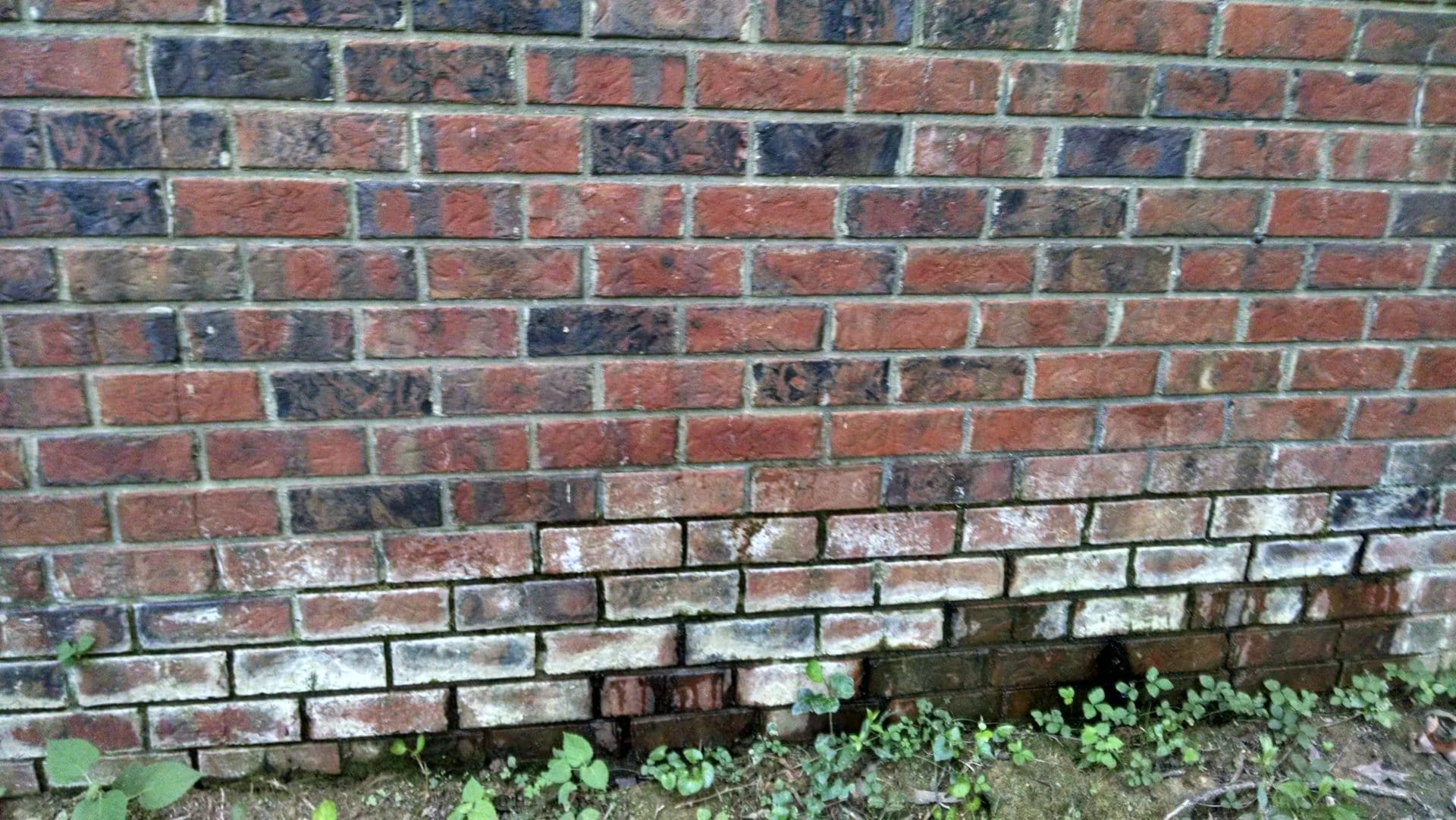 3. Foundation Defects
3. Foundation Defects
The Claim
The Allegation
Less than a month post inspection, a home inspector received an attorney letter alleging that he failed to detect an active water leak in a bedroom and its bathroom, which led to foundation issues. According to the letter, the claimants “discovered [the substantial water leak] almost immediately…upon taking actual possession of the home.” Further, the attorney argued that the damage caused by the leak was so excessive that the foundation was “severely compromised” and required “immediate repairs.” Without giving any indication to the cost of such repairs, the attorney gave the inspector six days to contact him before he would file a formal law suit.
As every inspector should, our home inspector contacted us immediately to report the incident. In discussing the case with the claimant’s attorney, our claims team learned that the bathroom’s plumbing was improperly draining into a void beneath the house. Although the leak itself was concealed and, therefore, unidentifiable at the time of the inspection, the attorney alleged that water from the leak was seeping through the exterior brick wall. While the leak itself was not visible, the claimants’ argued, the damage was outside the home.
While the home inspector did note uneven floors in the bedroom in his report, his report did not recommend further evaluation. Additionally, the realtor had told the home inspector that the floors were uneven floors because the last homeowner used a walker to get to the bathroom, and the inspector had verbally accepted this explanation.
The Resolution
Upon discussing the allegations with the inspector, our claims team learned that there had been bushes and overgrowth concealing the exterior wall at the time of the inspection. Therefore, the water damage had not been visible. However, the inspector did not mention any hindrance of view because of vegetation to the exterior brick wall, nor did he have a photograph showing the obstruction.
Despite extensive negotiations with the claimant’s attorney, the claimant has been unwilling to admit the inspector’s lack of liability. Further, the claimant refuses to lower their tens-of-thousands-of-dollars demand. Our claims team continues to defend this inspector from the claimant’s allegations years after the inspection and initial demand occurred.
Key Takeaways
As we discussed in our stand-alone article regarding foundation claims, foundation problems are easy to miss and even easier to cover up:
In an industry inundated with meritless claims, it’s important to watch your back. Real estate agents, home buyers, home sellers, and home inspectors all have important roles to play in real estate transactions, which work best when everyone plays their roles with totality and integrity.
Unfortunately, each party’s best interests do not always align. A real estate agent’s primary motivation may be a home’s sale. A buyer may wish to avoid paying for large repairs. A seller’s main aim may be to walk away with the highest offer on their house. Home inspectors, whose job is to point out defects, often seem to be at odds with the other players.
….
Which brings us to the uncomfortable truth: We’ve seen our fair share of claims in which the inspector would have seen the signs of foundation damage had the signs not been concealed, had the inspector not been distracted, or had the area been accessible. If red flags are going up during your inspection, we invite you to ask: What’s the reason?
Many of the facts suggest that these claimants purposely concealed known defects in order to bill the inspector for repairs. We urge home inspectors to be aware of what’s going on around them and to ask questions. Prioritize your business’ safety to avoid malicious claims.
Documentation
A large part of protecting your business involves documenting your home inspection and preserving your inspection assets. Photographs of non-defect, inaccessible, and concealed areas have saved many of our home inspectors from meritless claims. Such records could have greatly aided the inspector in the example above. It may seem tedious taking photo after photo. However, inspection photos are one of the best ways to manage risk. Don’t let your next allegation be a battle of “he said, she said.” Take lots of pictures so that you have a photo to back you up in every scenario. (Learn more about taking inspection photos to manage your risk here.)
Note that taking photos and creating records is half the battle. The other half is having them at the ready when a claim comes along. Claims professionals recommend keeping inspection assets at least five years, regardless of the statute of limitations in the inspector’s area. We strongly encourage you to follow their counsel. After all, you never know when you’ll need that photo of the bush in front of the property’s exterior wall. (Read more about storing inspection assets here.)
To learn more about foundation defect claims and how to avoid them, read our stand-alone article on the subject here.
 4. Mold
4. Mold
The Claim
The Allegation
Two months post inspection, another home inspector received a letter from his client demanding tens of thousands of dollars in remediation, repairs, medical bills, and rental costs in association with mold he’d found in the home.
The client stated that he was aware that he did not order a mold inspection. However, he believed that the home inspector should have documented the mold and recommended further testing anyway. Why? Because the mold was visually identifiable. Additionally, the client had since hired mold inspectors and remediators to visit the property to provide quotes for cleanup. Those mold inspectors implied that the home inspector should have identified the mold. The client claimed that the mold was “toxic,” thus causing him and the other occupants to seek medical attention. Further, the client stated that they couldn’t enter the home without respirators.
The Resolution
After the home inspector reported the claim, our team issued a denial of liability letter to the claimant. In it, they highlighted the general exclusions in the pre-inspection agreement, which included mold. The exclusion stated that it was “the responsibility of the client to conduct further inspection by qualified consultants to disclose the presence of contaminants and the means of remediation.” Additionally, our claims professionals cited the International Society of Home Inspectors (InterNACHI) Standards of Practice (SOP), which specifically precludes mold identification.
In response, the claimant stated he was “very disappointed” and called our claims team “very unprofessional.” However, the claimant ceased demands. The claim was closed at no cost to the home inspector—not even the cost of his deductible. (Learn more about the difference between simple deductibles and self-insured retentions here.)
Key Takeaways
Insurance Endorsements
Regardless of whether or not you decide to perform mold screenings, clients can file mold claims against you. In fact, most mold claims we receive are against home inspectors that do not perform mold inspections.
Thus, it’s essential to carry errors and omissions insurance (E&O) for defense and payout help. Further, if you want coverage for mold claims, most providers require that you purchase an endorsement, or policy add-on. This will allow you to have extra coverage against claims. (To learn about the Top 5 Claims home inspectors receive, click here.)
Additionally, those providers that include mold coverage outright often sublimit the mold endorsement. In so doing, those providers cap the mold endorsement’s limits of liability, meaning you get less coverage for mold claims. Such sublimits may cause you to unintentionally be out of compliance with your state or contractual obligations. (Learn more about sublimits here.)
Thus, it’s important to make sure to review your insurance policy. Verify what mold coverage your policy includes, if any, and what coverage you might add to limit your liability. Regardless of whether or not you’re insured with us, feel free to contact us if you need help understanding your insurance policy.
Pre-Inspection Agreements
Note the importance of the home inspector’s pre-inspection agreement in this particular example. The mold exclusion, the SOP, and the call for further inspection all emphasized that there wasn’t a mold inspection. Further, these contract clauses emphasized the client’s duty to hire separate consultants to investigate potential mold. Protect yourself from meritless claims by having clear and assertive exclusions and limitations of liability throughout your inspection contracts. And remember, if your clients don’t sign your contract prior to the home inspection taking place, your contract may not be admissible in court. Further, you may jeopardize your insurance coverage. (Read more about exclusions in pre-inspection agreements, including samples, here.)
To learn more about mold claims and how to avoid them, read our stand-alone articles on the subject: from our blog here and the ASHI Reporter here.
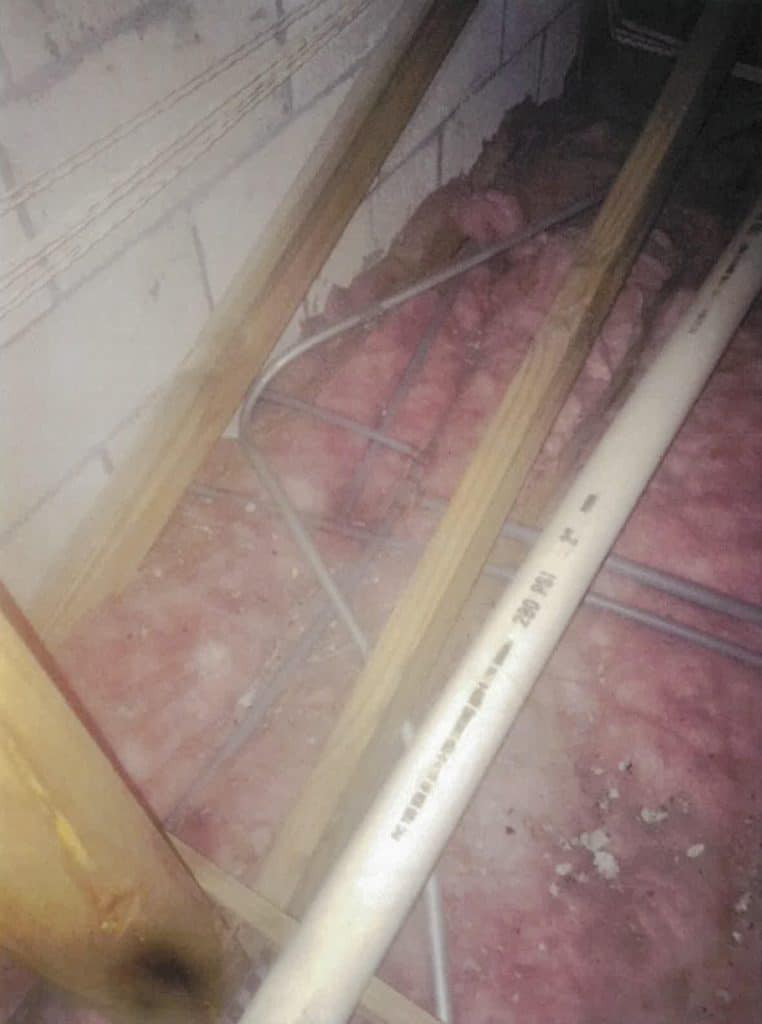 5. Plumbing Problems
5. Plumbing Problems
The Claim
The Allegation
Less than two months post inspection, a home inspector was notified by his client that polybutylene pipes were present in the attic of the property. Upon reinspection, the home inspector confirmed that there were, in fact, polybutylene pipes on the property.
Shortly thereafter, the inspector received an attorney letter alleging his failure to identify polybutylene pipes on the property. Prior to the inspection in question, another home inspector had performed a home inspection on behalf of another prospective buyer. That other inspector had determined the presence of polybutylene pipes. As a result, the prospective buyer chose not to purchase the client’s home.
According to the letter, the previous inspector’s discovery coupled with our inspector’s admission at the reinspection proved our inspector’s negligence. Therefore, the attorney argued, our home inspector owed the tens of thousands of dollars required to replace the polybutylene pipes on the property. The letter closed with a demand for the inspector’s insurance information.
Instead of notifying us immediately, the home inspector wrote his own reply to the attorney letter. In it, he explained that he had performed a limited, non-invasive condominium inspection that did not include the attic. The home inspector cited the section of his contract that explained the limitations of the inspection. Since the polybutylene piping was only visually identifiable in the attic, and the attic was not included in the inspection, the client should be responsible for the piping remediation, the inspector argued.
A week after the inspector sent his response letter, he received another letter from the attorney. It was at this point that the home inspector informed us of the situation.
The Resolution
Our claims team followed with its own letter, an official denial of liability to the claimant. In it, counsel cited the SOP and the inspection contract, both of which emphasized the limitations of the condominium inspection. Further, they emphasized that the pricing structure for the condo inspection takes the exclusion of common areas into account.
The client wasn’t satisfied. Without the assistance of their lawyer—presumably because the lawyer dropped the case—the client responded to our denial of liability letter. In their response, they argued that the polybutylene pipes were present in not just the attic but throughout the condo. Further, they re-emphasized the fact that another home inspector discovered the polybutylene piping.
Our claims team reasserted their defense of the home inspector, explaining that the polybutylene piping was only visible in the attic, which the inspector did not inspect and had no obligation to inspect. Regardless of where the piping existed in the condo, it wasn’t visible during the inspection and, therefore, out of scope.
Back and forth between our claims department and the claimant continued for several weeks. But in the end, the claimant ceased demands. We closed the claim at no cost to the home inspector—not even the cost of his deductible. (Learn more about the difference between simple deductibles and self-insured retentions here.)
Key Takeaways
While the claim itself was meritless, the home inspector made several errors that put his business at risk.
For one thing, home inspection insurance policies come with reporting policies. Reporting policies require inspectors to notify insurance companies of both claims and potential claims within a certain amount of time. Many insurance carriers require inspectors to notify them of claims and potential claims immediately so they can provide early defense. Our home inspector addressed the attorney letter on his own rather than reporting the claim immediately. In so doing, he put himself at risk of not receiving defense and payout help. Review your policy or ask your insurance broker to find out your carrier’s reporting policy. Then, be sure to abide by that policy to preserve insurance coverage.
Additionally, it’s clear that the client did not understand the terms of the inspection. Because polybutylene pipes existed in the condo, the claimant automatically assumed that the home inspector was obligated to report them. Be sure to provide a clear verbal and written definition of a home inspection—what it includes and what it doesn’t. Doing so may prevent clients from holding you accountable for issues outside of scope. (Read more about setting home buyers’ expectations, including defining a home inspection, here.)
To learn more about plumbing claims and how to avoid them, read our stand-alone article on the subject here.
Are home inspectors liable for missed items?
Reading about common claims, many wonder: Are home inspectors liable for missed items? If I overlooked something, can clients come after me? What if the defect went outside my standards of practice (SOPs)? Or what if it wasn’t even there when I inspected?
When it comes to claims, it’s not just a matter of whether or not you’re at fault. It’s about your client believing it’s your fault. Over 80 percent of the claims we receive are meritless, meaning the client is blaming their inspector for something they shouldn’t. But even if your client thinks you should have caught something, they can make a claim or file a lawsuit. Even if you do everything right, you can still get one of the top five claims.
Here’s the good news: As an exclusive home inspection insurance provider, we know the industry’s top claims inside and out. Our errors and omissions insurance (E&O) with the proper endorsements can give you the defense and payout help you need to fight back. Contact your InspectorPro broker or submit an application with us to receive a quote today.
Editor’s note: InspectorPro originally published a Top 5 Claims article in November 2016. However, this post has replaced that article to include more accurate, current, and comprehensive information. To protect the home inspectors’ anonymity, we have omitted locations and demand amounts.


